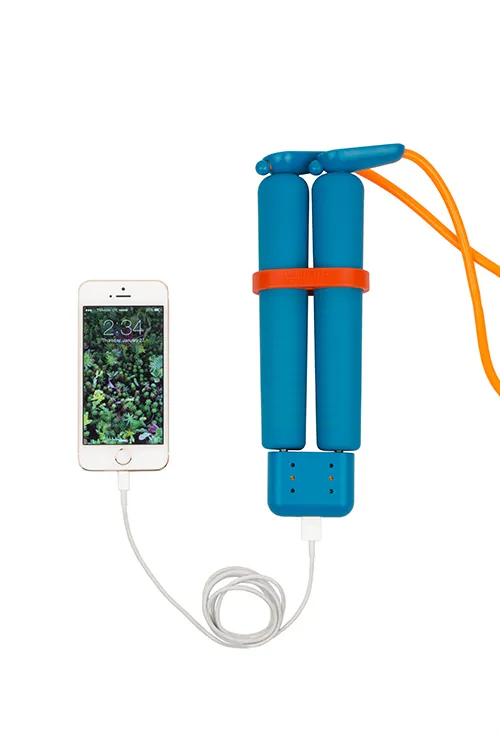These Soccer Balls and Jump Ropes Can Generate Power
Uncharted Play, a New York City-based startup, enables children in developing countries to build reserves of energy through play
/https://tf-cmsv2-smithsonianmag-media.s3.amazonaws.com/filer/ec/be/ecbe6796-bb4f-463f-866f-9eb05655b989/unchartedplay_soccket_008.jpg)
While visiting her cousins in Nigeria, Jessica Matthews noticed that the electricity would go out multiple times a day. While a diesel generator provided spotty support, it also spewed strong fumes.
“They couldn’t imagine a world where this wouldn’t be an issue,” she says. “They were in a hopeless situation, where daily life was continuously impacted.”
A few years later, in 2008, Matthews, then a junior at Harvard, was asked to invent a new product in a course called "Enginnering Sciences 20: How to Create Things & Have Them Matter." The device had to help address a key challenge in developing countries. Like Matthews, her teammates, Julia Silverman, Jessica Lin and Hemali Thakkar, had visited or worked in places where there are major gaps in energy resources.
For the assignment, the four students invented Soccket, a soccer ball that supplies electrical energy. A pendulum within the ball captures the kinetic energy generated as it moves around, driving a motor and charging a Lithium ion battery inside. After one hour of play, one ball is able to power an LED lamp for three hours. (Soccket plugs directly into a lamp, also designed by the students.) Fully charged, the ball can fuel the same LED light for 72 hours.
Matthews and her teammates began by experimenting with everyday items. To test the logic behind Soccket, they taped a shake-to-charge flashlight inside a hamster ball. By rolling the rough contraption back and forth, they proved the concept could ultimately work. The next prototype featured that same flashlight embedded inside a Nike soccer ball.

They tested the soccer ball in the field with users and received feedback. The product needed to be light yet durable enough to withstand significant force, so that the delicate guts of the ball wouldn’t get damaged.
“We basically needed to create a cell phone that you could kick and smash against the wall, and that was soft enough that you could bounce,” Matthews says.
After graduation, in 2001, Matthews and Silverman founded the company Uncharted Play to develop their prototype into a viable commercial product.
“Engineers, to our face, said it was not possible,” says Matthews. But, they continued to research vendors and examine the materials companies like Nike and Adidas use for soccer balls, looking for something with some cushion to protect the pendulum, motor and battery inside their ball. “Building the actual ball was the hardest part, not the mechanism inside,” she says.
After countless versions, the team arrived at a working model. Weighing 17 ounces, is only one ounce heavier than a standard-issue soccer ball. “The process was about incrementally making a little bit of an improvement, a little bit more and a little bit more,” Matthews says.
Each Soccket has a tiny orange rubber stopper in it. Remove it, and a user can plug an LED lamp that comes with the product directly into the ball. The $99 Soccket follows the same buy-one-give-one model as Toms shoes. For each Soccket purchased, one is given to a child in need. Other devices, including phones and water filtration machines, can also be charged using the Soccket and a USB add-on.
Since its launch, Uncharted Play has sold and distributed more than 50,000 units in Brazil, Nigeria, Haiti and other countries. President Barack Obama, Bill Clinton and Bill Gates have all kicked a Soccket.
Matthews has also developed a jump rope, called the Pulse. The energy-capturing device is housed in the jump rope's handles and harnesses the kinetic energy from the rope's rotations. The Pulse is able to generate four times the power of a Soccket—15 minutes of jumping results in two hours of light.
Uncharted Play would like to make more connected versions of their existing products that would track how much energy each device generates and how that energy is being used. Matthews is also curious about how their energy-capturing technology can be integrated into other items that people already use. Her hope is to continue pursuing ideas that offer new perspective on objects that are already part of people’s lives.
“Who would have thought a soccer ball could also be a source of power?” she says.
/https://tf-cmsv2-smithsonianmag-media.s3.amazonaws.com/accounts/headshot/profile.jpg)
/https://tf-cmsv2-smithsonianmag-media.s3.amazonaws.com/accounts/headshot/profile.jpg)